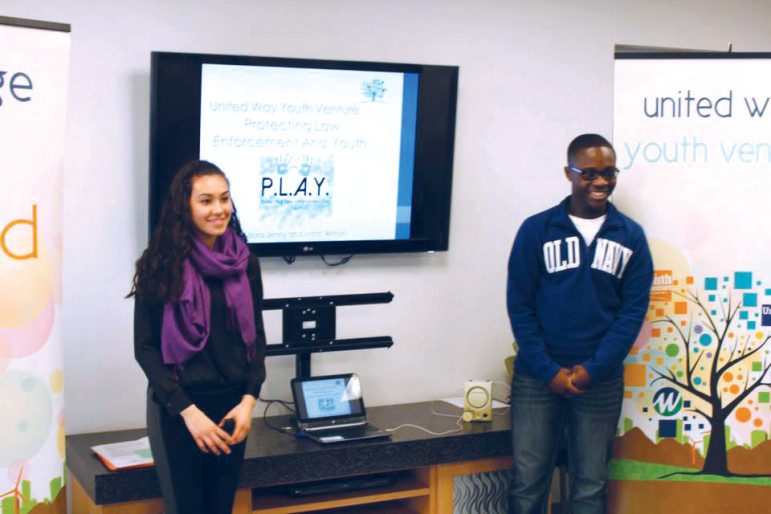
In the wake of a series of cases in which young people lost their lives during fatal encounters with police, many young Americans have expressed their outrage over the needless loss of life in the form of protest.
At the Boys & Girls Club of Fitchburg and Leominster in Massachusetts, club member Laura Jenny, 16, and her schoolmate, Isaac Annan, 15, have taken a decidedly different approach.
Assisted by a club mentor, a school counselor and a seed grant they secured from United Way Youth Venture, the pair helped create a program called Protecting Law Enforcement and Youth — or PLAY — to educate kids how to interact safely with the police.
A youth-led approach to prevention
The program features an interactive game called “Juvenile Justice Jeopardy” — developed by a Cambridge, Mass., organization called Strategies for Youth — that Laura and Isaac helped bring to the club in order to further the goals of PLAY.
[Related: Teen Siblings Create App to Monitor Police Interactions With Civilians]
The city of Leominster, a predominantly white city located in north central Massachusetts, may be a far cry demographically from urban locales where some of the most recent deaths of young black men during encounters with police have occurred. Still, Laura and Isaac’s efforts represent part of a growing trend of young people being more proactive about preventing more young people from losing their lives needlessly at the hands of police.

Photo courtesy of Laura Jenny
Laura Jenny (left) and Isaac Annan present their idea to United Way Youth Venture, promoting a new way to educate their peers about interacting safely with local police.
They are moved to act in part by cases such as 12-year-old Tamir Rice, who was shot and killed by Cleveland police last November near a recreation center where he had been wielding a fake gun. He was shot just moments after police arrived and saw him reach for what ended up being a toy gun in his waistband.
“All of those could have been prevented by kids knowing how to act when they’re approached by a cop,” Isaac said. “We thought this would be a better way to show our concern instead of going out protesting.”
Laura said many young people “don’t know anything better” when dealing with police and may instinctively decide to run.
“They don’t know how they should behave,” Laura said, explaining the need for young people who are stopped by police to — among other things — not make any sudden movements and to be respectful throughout the encounter.
Cop classes becoming more common
Isaac and Laura are by no means alone in their push for more education for young people about the best way to respond during their dealings with police.
Consider, for instance, the following:
- In New Jersey, four lawmakers from Essex County have proposed a law that would require school districts to teach classes next school year on how to interact with law enforcement officials. Among other things, the classes would teach “an individual’s responsibilities to comply with a directive from a law enforcement official.”
- In New York City, a Brooklyn school principal invited staff from the New York Civil Liberties Union — or NYCLU — to conduct a schoolwide class on how to deal with the police. The class — actually a two-day seminar — was dubbed “Cops 101.”
- In Akron, Ohio, a youth service organization known as the Akron Peacemakers created thousands of crib sheets titled “You and the Law: Guidelines for Interacting with Law Enforcement,” to distribute to local young people. The write-up advises young people to answer all questions pertaining to their identity, not to “badmouth” or walk away from the police, and to consent to a patdown if an officer has a “reasonable suspicion” that the young person may be carrying a weapon or illegal substance.
Willa Keith, a former Akron police sergeant who now serves as program coordinator at the Akron Peacemakers, says the crib sheets — also referred to as palm cards — have been in high demand nationwide since young people involved in the program condensed an older version of the guidelines into its current form.
“We’ve gotten over 35 calls either to use the ‘You and the Law’ cards or to help them start a Peacemakers group in their city,” Keith said. Calls have come in “all the way from Alaska to Maine to New Mexico to Florida.”
Responsibility without rights?
While the cop classes and palm cards have garnered support among educators and those who work in the youth services field, they are also generating a fair amount of criticism.
One of the biggest criticisms is that this instruction — the classes and crib sheets — seems heavy on advice about what young people are supposed to do during their encounters with law enforcement but light on what their rights are during those encounters.
Ari Rosmarin, public policy director at the American Civil Liberties Union of New Jersey, said the proposed New Jersey law that would require school districts to offer classes on how to deal with the police does not go far enough to make sure those classes teach young people about their rights.
The text of the proposed law says classes should deal with “the role and responsibilities of a law enforcement official in providing for public safety,” as well as “an individual’s responsibilities to comply with a directive from a law enforcement official.”
“The piece that was missing is what young people’s rights are when interacting with police and how to exercise those rights,” Rosmarin said.
“I don’t think it’s a bad idea, particularly in light of what we know about policing, teaching young people how to be safe in those encounters,” Rosmarin continued. “But put that education in context of what their rights are.”
Rosmarin and others concede, however, that advising young people to exercise their rights while dealing with police can be a dicey thing to do.
“There’s your rights on paper, and then there’s the reality in the street,” Rosmarin said. “Those are not, in practice, the same things.”
Candis Tolliver, assistant advocacy director for organizing at the NYCLU, agreed there’s a tension between how in the classroom she encourages young people to assert their rights vs. their ability to actually do so when they are in real-life situations on the streets. Tolliver is one of several NYCLU staff members who taught a two-day seminar at East Side Community High School in Brooklyn on how to interact with the police.
The rights-versus-reality dilemma is particularly true, she said, for young people who are from racial minority groups when dealing with police officers with racist views.
“What is really important for me, especially as an African-American woman, is to make sure people are safe and people are walking away from these encounters not ending up like Freddie Gray or anyone else,” Tolliver said, referring to the case of the 25-year-old Gray, a black resident of Baltimore who suffered a fatal spinal injury while in police custody this past this past April. Six Baltimore police officers are facing charges in connection with Gray’s death. (See photo essay on JJIE.org)
News reports indicate Gray was arrested after he made eye contact with a police officer in a “high-crime” area and ran. The state’s attorney has said police had no reason to stop Gray.
Addressing bias and police responsibility
“We want young people of color to be aware that it takes very little for adults to perceive them as dangerous and call the police on them,” said Lisa H. Thurau, founder and executive director of Strategies for Youth, the Massachusetts organization that created the game, which addresses racial bias. “We want them to be aware of how others see them and be strategic about how they behave because the stakes are so high.”
Sherrilyn Ifill, president and director-counsel for NAACP Legal Defense and Education Fund, broached the need for better police training during a recent plenary session at the W.K. Kellogg Foundation’s 2015 America Healing Conference.
Ifill recommended the federal government use grants to incentivize changes in police behavior and departmental practices nationwide. Specifically, she suggested $1 billion in annual grants be released contingent on training to manage “implicit bias,” as well as training to de-escalate encounters, especially with young people.
Melanca Clark, chief of staff in the Office of Community Oriented Policing Services at the U.S. Department of Justice, said her department plays a quiet role helping police departments address specific issues.
She said jurisdictions may seek help through the Collaborative Reform for Technical Assistance program to deal with issues that range from assessments of use- of- force policies to community engagement. Clark said her office assists “police departments that want to be productive on their own without the hammer of a court order.”
Police training issues notwithstanding, the need for young people to know the dos and don’ts of dealing with the police remain.
For perspective, fatal police shootings of minors are relatively rare. To wit, when the Washington Post conducted an analysis of police shootings during the first five months of 2015, the newspaper found that only eight of the nearly 400 fatal police shootings during that time period involved victims under the age of 18. And 55 involved young people age 18 to 24. The biggest age group —118 — involved people age 25 to 34.
Be that as it may, the ones that do involve minors are no less tragic. The other thing to keep in mind is that avoidance of being shot by the police is just one objective, albeit a critical one, of the classes that teach young people how to deal with the police. The overall objective is to make the encounters go as smoothly as possible without any unnecessary citations or altercations, or being placed in the back of a police cruiser or even a holding cell when a little respect and compliance can prevent those kinds of negative outcomes.
Tolliver, of the NYCLU, said while young citizens are not legally required to answer questions from police, there are situations where it is not expedient to exercise that right.
“While there’s a right not to answer questions from an officer, what does that look like at 12 a.m. in the South Bronx on a dark road and it’s just you and the officer?” Tolliver said.
“It’s about rights versus reality,” Tolliver said. “I don’t encourage people to relinquish their rights. But when it’s a conflict between rights and safety, I always want people to be safe first.”
Along those lines, Tolliver teaches young citizens that while they are not required to show officers their ID, sometimes it helps to do so as a “de-escalation tactic.”
“In the South Bronx at 12 a.m. with four officers, that would be my response. ‘I’ll show you my ID. I’ll reach into my purse and grab it,’ even though legally you’re not required to show them ID,” Tolliver said.
The palm cards and classes have also been criticized for ignoring or downplaying the responsibilities that police have to abide by the law when engaging the public and to not resort to excessive force.
Natasha C. Pratt-Harris, associate professor and criminal justice program coordinator in the Department of Sociology & Anthropology at Morgan State University in Baltimore, said classes on how to interact with the police won’t make much of a difference if law enforcement officers don’t obey the law themselves.
“I’ve seen those courses consistently being held over the course of my lifetime,” Pratt-Harris said. “But if the officers themselves aren’t following the rule of law, all the training in the world for citizens or residents — it doesn’t matter.”
To bolster her point, Pratt-Harris cited the April 2015 killing of Walter Scott, who was shot in the back and killed by a police officer in South Carolina as he ran away from the officer in an incident captured by cell phone video.
“When you’re running away, it seems as if you are not trying to harm the assailant. You’re actually trying to get away from them,” Pratt-Harris said. “But if the person is out to get you, there’s nothing you can do.”
At the same time, Pratt-Harris said there’s a need to teach young people not to run in the first place.
“If I were to have a son, I would tell him, ‘Always look them in the eye,’” Pratt-Harris said. “And if they think they’re being suspicious or doing something wrong, you say, ‘Hello. Is there something I can help you with?’ Don’t respond in fear.”
That is one of the main lessons that comes in Juvenile Justice Jeopardy.
Diana, 13, a Boys & Girls Club member who participated in the game, said she learned from the game “not to run, not to be disrespectful, not to do really quick stuff, not to pull something out because they might think it’s a gun or something.”
Thurau, of Strategies for Youth, said she is surprised as to how poorly many young people understand what the police can and can’t do to them during a stop.
“Routinely to this day we hear kids say a male police officer cannot pat down a female,” which is not true, Thurau said. “It’s astonishing to us how poorly that is understood. We hear many things like ‘An officer needs a warrant to talk to me. I know my rights, and you can’t do that.’ And unfortunately they don’t know their rights.
“They are kind of hurting themselves often by taking this approach of the best defense is an offense,” Thurau said. “And while it makes sense, it doesn’t serve them well. In the police setting, in fact, it often hurts them.”
Don’t miss these sidebars:
Interacting With Police: Teens Lead in Training Peers
Police Official Says Game Helps Officers Make Inroads Among Youth
Other related stories:
Opinion: Practice These Skills to Help End Police-Community Tragedies
Report Helps Police Protect Kids While Arresting Their Parents
When Kids Are Killed by Police


























